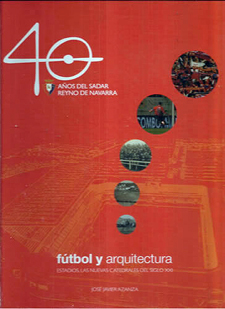40 years of the Sadar-Reyno de Navarra.
Soccer and architecture: Stadiums, the new cathedrals of the 21st century.
|
presentation |
11 |
|
Foreword |
15 |
|
I. Stadiums, from earthen esplanades to large multifunctional complexes. |
18 |
|
II. From the Ensanche field to the Reyno de Navarra: a tour through the stadiums of C.A. Osasuna. |
40 |
|
III. The League teams and their stadiums, one by one. |
114 |
|
bibliography |
276 |
In 2005, the Chair de Patrimonio y Arte Navarro, sponsored by the Government of Navarra, was created within the department of Art History of the University of Navarra. Among the aims pursued by the Chair is the work of dissemination of artistic heritage through the partnership with local, cultural, religious and social initiative entities, in order to raise awareness of our heritage and involve the different social sectors in its knowledge and conservation.
Faithful to its objectives and in the framework to open new channels of partnership with Navarrese entities of different nature, the Chair de Patrimonio y Arte Navarro joins the commemoration of the 40th Anniversary of the Sadar-Reyno de Navarra Stadium to edit, in partnership with the Osasuna Foundation, the book Fútbol y Arquitectura. Stadiums, the new cathedrals of the 21st century. On the 40th anniversary of the Sadar-Reyno de Navarra, by the professor of the Chair José Javier Azanza López. An innovative and highly topical topic that links sport and art, soccer and architecture in the right balance, to provide content and projection to the celebration of this anniversary.
José Javier Azanza's suggestive tour through the architectural typology of soccer stadiums shows the great transformation that has taken place in these sports venues in little more than a century. Thus, the rudimentary scenarios that around 1900 hosted the internship of this sport, have given way one hundred years later to a new generation of postmodern stadiums, whose design to position of the most renowned architects and programs of study architecture worldwide, and its flexible and multifunctional nature capable of hosting all subject uses, elevates them to the category of "Cathedrals of the XXI Century".
As an integrating element of a context that contributes to define and develop, the design of soccer stadiums has attracted the interest of qualified representatives of the Spanish architectural panorama of the twentieth century. accredited specialization In a wider context that the author of this book masters, the architect Tomás Arrarás, author of the project for the enlargement of the San Juan Field, as well as of the plans according to which the Sadar Stadium was inaugurated in 1967, is a must.
But together with the possibilities offered by topic in subject of architecture and urban planning, José Javier Azanza, a good connoisseur of the history of soccer and follower of the vicissitudes of the League and its teams, does not forget the sporting context that a work of such a nature requires. In this way, he elaborates an open text addressed to a plural reader, from the soccer fan in general, to the partner and sympathizer of Club Atlético Osasuna, without leaving aside those interested in art and architecture, and to those who feel attracted by those matters related to the history of Pamplona and Navarra. All this combining the documentary rigor that must be demanded to any work of research, with the simplicity and amenity in its exhibition, and the attractiveness of the photographic material compiled.
Coinciding with a period of achievements for Club Atlético Osasuna, the publication of the book Fútbol y Arquitectura. Stadiums, the new cathedrals of the 21st century. En el 40 aniversario del Sadar-Reyno de Navarra, becomes an excellent way to commemorate the 40th anniversary of the Sadar-Reyno de Navarra Stadium.
María Concepción García Gainza
Director of the Chair de Patrimonio y Arte Navarro (Navarrese Heritage and Art)

